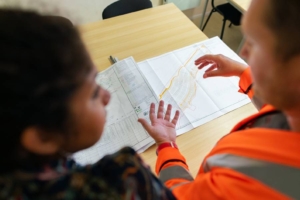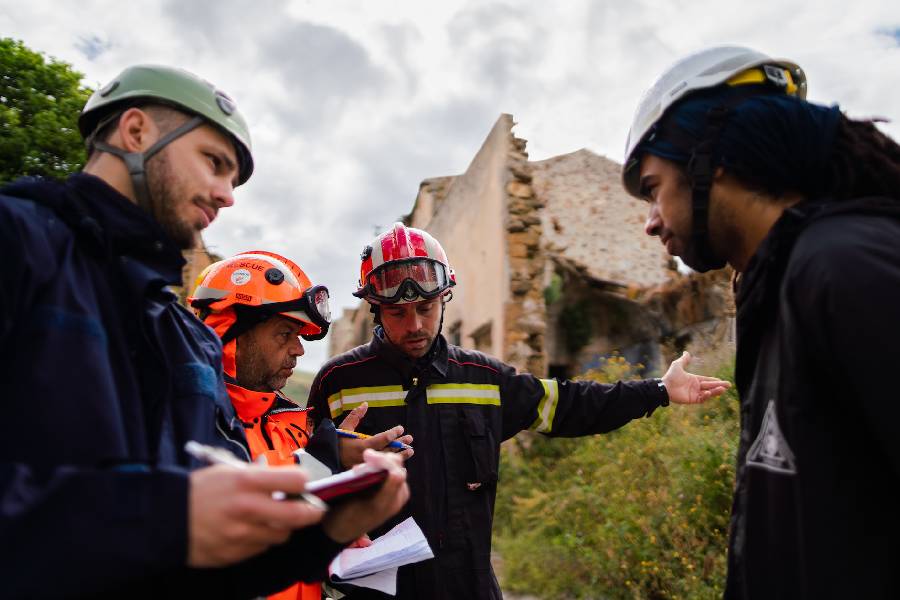The design phase of civil engineering projects is a critical step where engineers transform concepts into actual structures. However, this phase is fraught with numerous challenges and complexities. So, we will explore some of the most common civil engineering design problems and the innovative solutions that engineers employ to overcome them.
Let’s discover more!

Common Civil Engineering Design Problems
Various design challenges demand innovative solutions within the multifaceted domain of civil engineering. But what do civil engineers have to consider when designing?
Environmental considerations, geotechnical challenges, regulatory requirements, and the constraints of project budgets and schedules all converge to define the path that civil engineering design must take. Hence, we categorize these hurdles into six primary areas:
Structural design problems
Structural design, the civil engineering bedrock, is a crucial discipline. It’s the art of ensuring that buildings, bridges, and various constructions provide stability and security. Structural design forms the cornerstone of our built environment.
This discipline is where Cypress Engineering’s expertise shines. We provide assurance for every project we undertake. Whether facing the tests of time or nature’s forces, our structures stand resilient.
Material compatibility challenges
Navigating material compatibility poses a fundamental challenge in structural design. Selecting the suitable materials is imperative. We must also ensure compatibility between materials and suitability for the environment. These factors are paramount for the safety and durability of the structure.
However, failures in material compatibility can degrade structures. This jeopardizes safety and longevity. So, we employ rigorous material analysis and selection processes. This guarantees the seamless functioning of each component within the overall structure.
Dynamic vibrations and structural stability
The dynamic nature of the world presents a unique challenge in structural engineering. Structures are not isolated entities but interact with the environment. They respond to external factors such as wind, seismic activity, and even human-induced vibrations.
Ensuring structural stability under these dynamic conditions requires advanced analysis and design techniques. Our experts leverage cutting-edge technology to conduct dynamic analyses, safeguarding structures against unexpected forces and ensuring the safety of all who use them.
Geotechnical design problems
The interplay of the constructed environment with the Earth underneath poses particular issues. Geotechnical design problems encompass soil-structure interactions, slope stability, and the complex task of managing groundwater.
These issues encompass a broad spectrum of concerns, from understanding the dynamics of soil-structure interactions to addressing slope stability and managing groundwater effectively.
Cypress Engineering’s expertise in geotechnical design navigates these complexities with precision. We ensure that every project we undertake is built on a solid foundation.
Soil-structure interactions – building on solid ground
Understanding soil-structure interactions is fundamental for geotechnical design. The soil characteristics profoundly impact a structure’s stability and longevity.
Therefore, our engineers profoundly analyze soils. We evaluate properties like composition, density, and load-bearing capacity. This information serves as the foundation for our designs. We craft designs that harmonize with the earth below, which enhances structural integrity.
Conquering the slope stability challenge
In regions where topography introduces slopes and gradients, the challenge of slope stability becomes a focal point of geotechnical design. Ensuring that the ground upon which structures are built remains secure, even on sloping terrain, demands innovative solutions.
So, we employ advanced analytical tools and techniques to assess slope stability, allowing us to design structures that stand the test of time while adapting to diverse landscapes.
Mastering groundwater management
Groundwater, while a valuable resource, can pose significant construction challenges. Effectively managing groundwater levels to prevent flooding and structural damage is a crucial aspect of geotechnical design.
Our specialists are well-versed in hydrogeology, implementing comprehensive strategies to control groundwater and safeguard construction sites and structures.
Hydraulic design problems
Managing water, which is one of our most vital resources, is a fundamental part of civil engineering. Design challenges encompass stormwater management, drainage and sewer system complexities, and creating hydraulic structures for water supply.
At Cypress Engineering, we bring our expertise to these multifaceted issues, guaranteeing that water resources are harnessed effectively and efficiently.
Ensuring effective stormwater management
Managing stormwater flow is a fundamental concern in hydraulic design. Engineers must create drainage systems that effectively channel rainfall. Well-designed systems prevent flooding and erosion, ensuring rainfall doesn’t wreak havoc on urban areas.
Hence, we craft innovative stormwater management plans to achieve this crucial goal. Our designs protect communities and infrastructure from the unpredictability of weather patterns.
Addressing the complexities of drainage and sewer systems
Drainage and sewer systems, concealed beneath our cities, form the invisible heroes of urban living. They transport wastewater away from our daily lives, ensuring public health and sanitation.
Designing and maintaining these intricate systems is a core part of hydraulic design. Our experts understand the intricacies of drainage and sewer systems, creating solutions that keep our cities clean and healthy.
Crafting hydraulic structures for reliable water supply
Hydraulic structures guarantee our water supply. They ensure reliable water flow to homes and businesses. Designing these structures requires understanding fluid dynamics. It also requires durable materials.
Cypress Engineering excels at creating hydraulic structures. Our designs provide consistent, safe community water supplies even under the most demanding conditions.

Transportation design problems
Modern society depends on efficient transportation. Civil engineers tackle infrastructure design problems to ensure the smooth flow of traffic and efficient connectivity between places.
Optimizing traffic flow
A smooth traffic flow is essential to prevent congestion and reduce travel times. In this context, civil engineers are tasked with devising solutions that optimize traffic flow through roadways and transportation systems.
- Innovative traffic control systems — Implementing advanced traffic control systems, such as intelligent traffic lights and dynamic traffic management, helps regulate traffic flow and minimize congestion.
- Public transit enhancements — Promoting public transportation options, including efficient bus routes and accessible rail systems, aids in reducing traffic volume and alleviates congestion on roadways.
- Smart infrastructure design — The design of well-planned road networks, on-ramps, and off-ramps that ease traffic bottlenecks and enhance the flow of vehicles.
Enhancing connectivity
Efficient connectivity between places is necessary for socioeconomic growth and accessibility. Civil engineers contribute to this by designing infrastructure facilitating ease of movement and connectivity.
- Bridge and tunnel construction — Building bridges and tunnels over challenging terrains like rivers and mountains is vital in establishing seamless connectivity. Civil engineers must overcome unique design challenges in such projects.
- Intermodal transportation hubs — The creation of intermodal transportation hubs, where different modes of transportation converge, ensures efficient transfers for passengers and cargo.
- Pedestrian and cyclist-friendly initiatives — Promoting walkability and cycling options within urban areas reduces traffic congestion and enhances connectivity.
By addressing these intricate transportation design problems, civil engineers play a crucial role in shaping the future of modern society, fostering a world where mobility is efficient, sustainable, and accessible to all.
Environmental design problems
Sustainability and environmental responsibility are now paramount. Civil engineers integrate green infrastructure and adapt to climate change. Our engineers also mitigate noise, air, and water pollution through their design.
Integrating green infrastructure
The incorporation of green infrastructure is crucial. Civil engineers are crafting solutions that blend the urban environment with nature. Innovations like green roofs, pervious pavements, and sustainable landscaping promote biodiversity and cleaner air.
Adapting to climate change
In the face of a changing climate, adaptability is key. Civil engineers are designing resilient infrastructure to withstand floods, combat coastal erosion, and manage stormwater effectively. This is essential to protect communities.
Mitigating pollution
Nowadays, pollution control is a top priority. Civil engineers implement noise reduction, air quality improvements, and water pollution prevention. This contributes to healthier, cleaner environments.
Managing budgetary constraints problems
Budgetary constraints often emerge as a significant civil engineering design problem. Balancing quality materials, technology, and skilled labor with limited finances poses a formidable challenge. Our experts also work closely with clients to set realistic budget expectations. This ensures feasibility while delivering exceptional results.
Incorporating value engineering
One of the key ways we address this challenge is through value engineering. This process involves a meticulous analysis of project components to identify cost-reduction opportunities without compromising integrity or function. Value engineering allows us to maximize project value within budget constraints. It ensures efficient resource utilization and long-term sustainability.

Conclusion
There are many civil engineering design problems – structural integrity, geotechnical stability, hydraulic systems, transportation networks, and environmental sustainability. At Cypress, our expertise allows us to tackle these problems through diligent analysis, rigorous planning, and innovative solutions.
Every day, we creatively overcome hurdles to shape infrastructure serving communities now and in the future. Our passion drives us to set new, responsive, cutting-edge engineering design standards.
Altogether, we remain dedicated to building a brighter world through expertise and ingenuity!
